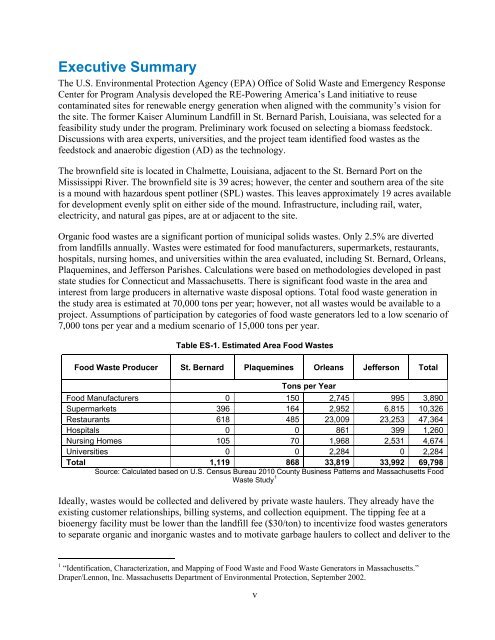Feasibility Study of Anaerobic Digestion of Food Waste in St - US ...
Feasibility Study of Anaerobic Digestion of Food Waste in St - US ...
Feasibility Study of Anaerobic Digestion of Food Waste in St - US ...
Create successful ePaper yourself
Turn your PDF publications into a flip-book with our unique Google optimized e-Paper software.
Executive Summary<br />
The U.S. Environmental Protection Agency (EPA) Office <strong>of</strong> Solid <strong>Waste</strong> and Emergency Response<br />
Center for Program Analysis developed the RE-Power<strong>in</strong>g America’s Land <strong>in</strong>itiative to reuse<br />
contam<strong>in</strong>ated sites for renewable energy generation when aligned with the community’s vision for<br />
the site. The former Kaiser Alum<strong>in</strong>um Landfill <strong>in</strong> <strong>St</strong>. Bernard Parish, Louisiana, was selected for a<br />
feasibility study under the program. Prelim<strong>in</strong>ary work focused on select<strong>in</strong>g a biomass feedstock.<br />
Discussions with area experts, universities, and the project team identified food wastes as the<br />
feedstock and anaerobic digestion (AD) as the technology.<br />
The brownfield site is located <strong>in</strong> Chalmette, Louisiana, adjacent to the <strong>St</strong>. Bernard Port on the<br />
Mississippi River. The brownfield site is 39 acres; however, the center and southern area <strong>of</strong> the site<br />
is a mound with hazardous spent potl<strong>in</strong>er (SPL) wastes. This leaves approximately 19 acres available<br />
for development evenly split on either side <strong>of</strong> the mound. Infrastructure, <strong>in</strong>clud<strong>in</strong>g rail, water,<br />
electricity, and natural gas pipes, are at or adjacent to the site.<br />
Organic food wastes are a significant portion <strong>of</strong> municipal solids wastes. Only 2.5% are diverted<br />
from landfills annually. <strong>Waste</strong>s were estimated for food manufacturers, supermarkets, restaurants,<br />
hospitals, nurs<strong>in</strong>g homes, and universities with<strong>in</strong> the area evaluated, <strong>in</strong>clud<strong>in</strong>g <strong>St</strong>. Bernard, Orleans,<br />
Plaquem<strong>in</strong>es, and Jefferson Parishes. Calculations were based on methodologies developed <strong>in</strong> past<br />
state studies for Connecticut and Massachusetts. There is significant food waste <strong>in</strong> the area and<br />
<strong>in</strong>terest from large producers <strong>in</strong> alternative waste disposal options. Total food waste generation <strong>in</strong><br />
the study area is estimated at 70,000 tons per year; however, not all wastes would be available to a<br />
project. Assumptions <strong>of</strong> participation by categories <strong>of</strong> food waste generators led to a low scenario <strong>of</strong><br />
7,000 tons per year and a medium scenario <strong>of</strong> 15,000 tons per year.<br />
Table ES-1. Estimated Area <strong>Food</strong> <strong>Waste</strong>s<br />
<strong>Food</strong> <strong>Waste</strong> Producer <strong>St</strong>. Bernard Plaquem<strong>in</strong>es Orleans Jefferson Total<br />
Tons per Year<br />
<strong>Food</strong> Manufacturers 0 150 2,745 995 3,890<br />
Supermarkets 396 164 2,952 6,815 10,326<br />
Restaurants 618 485 23,009 23,253 47,364<br />
Hospitals 0 0 861 399 1,260<br />
Nurs<strong>in</strong>g Homes 105 70 1,968 2,531 4,674<br />
Universities 0 0 2,284 0 2,284<br />
Total 1,119 868 33,819 33,992 69,798<br />
Source: Calculated based on U.S. Census Bureau 2010 County Bus<strong>in</strong>ess Patterns and Massachusetts <strong>Food</strong><br />
<strong>Waste</strong> <strong><strong>St</strong>udy</strong> 1<br />
Ideally, wastes would be collected and delivered by private waste haulers. They already have the<br />
exist<strong>in</strong>g customer relationships, bill<strong>in</strong>g systems, and collection equipment. The tipp<strong>in</strong>g fee at a<br />
bioenergy facility must be lower than the landfill fee ($30/ton) to <strong>in</strong>centivize food wastes generators<br />
to separate organic and <strong>in</strong>organic wastes and to motivate garbage haulers to collect and deliver to the<br />
1 “Identification, Characterization, and Mapp<strong>in</strong>g <strong>of</strong> <strong>Food</strong> <strong>Waste</strong> and <strong>Food</strong> <strong>Waste</strong> Generators <strong>in</strong> Massachusetts.”<br />
Draper/Lennon, Inc. Massachusetts Department <strong>of</strong> Environmental Protection, September 2002.<br />
v
















